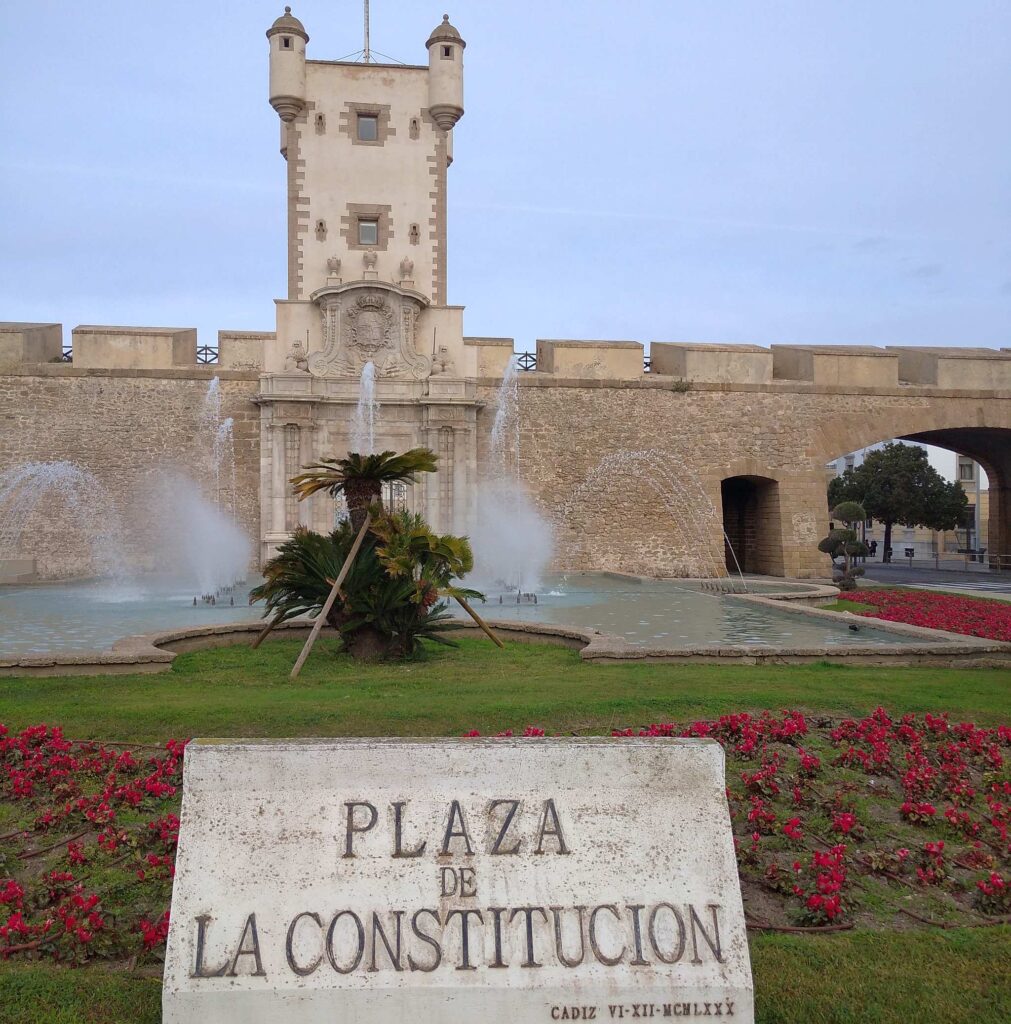The Puerta de Tierra is a historic gate located in the city of Cadiz. It dates back to the 16th century and served as one of the main entrances to the city, protecting it from sea attacks. The Puerta de Tierra is a symbol of the city’s rich history and has undergone several renovations throughout the years to maintain its original appearance. Today, it is a popular tourist attraction, offering a glimpse into Cadiz’s past and providing stunning views of the surrounding area. The Puerta de Tierra is a must-visit for anyone interested in the history and culture of Cadiz.
The audio guided tour of Cádiz

The Puerta de la Tierra is the starting point for our Cádiz audio guide. Read about the audio guide here: https://voicemap.me/tour/cadiz/the-ancient-city-by-the-sea-a-guide-to-charming-cadiz
Some history about the Puerta de Tierra in Cádiz
The tower and the upper avenue of the Puerta Tierra was reopened to the public in 2013. This original defensive wall holds great historical and cultural importance alongside the other numerous buildings and monuments in the city of Cádiz.
Search for other guided tours and activities in Cádiz here: https://visitingcadiz.com/guided-tours-and-activities-in-cadiz/
The Puerta de Tierra construction began during the16th century when the original medieval walls were to small and enclosed for the growth of the city. In 1574 an extension was made to protect it with two bastions. The whole structure was not completed until the eighteenth century.

In the middle, the entrance hall is framed by a marble frontispiece dated 1756. An inscription here refers to the construction of the door and is adorned with the royal coat of arms. There is an elegant marble portico in the shape of a triumphal arch designed by Torcuato Cayón. The walls known as San Roque and Santa Elena, named after the nearby hermitages, were demolished in 1737 due to the construction of the barracks within the area of the defensive complex.
The extension outside the walls led to the proposal, during the first half of the 20th century, to demolish the entire defensive complex. fortunately, though, it was decided to fill in the moats and open two large arches along the walls to allow the passage of vehicles at the time.

San Servando and San Germán
In the central square, next to the fountain there are two marble obelisks dedicated to San Servando and San Germán who are both patron saints of Cádiz.
These statues are rumored to have once been situated in Genoa at the beginning of the 1600s where they stood at the entrance to the Italian city’s port. They are made of Genoese marble and the sculptor is unknown.

These two brothers from the 3rd century were from Merida. Legionnaires of Rome, They met an untimely death in Morocco where they were beheaded for following the christian faith! The statues were placed here in 1945.
The Puerta de Tierra, in addition to the areas open for visits such as the central vault, the tower and the upper promenade, also houses the Lithographic Workshop Museum (tracing the art of ancient lithography through preserved stones & machine displays) and the Ibero-American Puppet Museum (a collection of puppets from around the world).
If the fountain is behind and you are facing the Puertas de Tierra, then the lithographic museum is to your left the other side of the road. The Puppet museum is on your right across the road in the direction that we are heading next.

Puerta de Tierra in Cádiz: Frequently Asked Questions
The Puerta de Tierra dates back to the 16th century and was built to defend Cádiz from sea attacks. Over time, it was expanded with bastions, a marble triumphal arch, and royal symbols. Its history reflects the city’s resilience, but there’s much more detail on its construction and later renovations in the full article.
This gate is one of Cádiz’s most iconic monuments because it symbolises the city’s defence and expansion. It was once part of the fortified walls and now offers cultural value as well as access to museums. Visitors often consider it a must-see when exploring Cádiz.
Yes, visitors can explore areas such as the central vault, tower, and upper promenade. It also houses two unique museums: the Lithographic Workshop Museum and the Ibero-American Puppet Museum. These attractions make the gate more than just a historic monument.
San Servando and San Germán are patron saints of Cádiz. Their marble obelisks stand near the gate, but their story is far older. Both were Roman legionnaires from Mérida, executed for their Christian faith in Morocco. Their statues, brought from Genoa, were placed in Cádiz in 1945.
The Puerta de Tierra is often the starting point for Cádiz audio and walking tours, including Clive’s VoiceMap guide. Beginning here gives visitors a sense of the city’s history before exploring its charming streets and coastal views. More tour details can be found through the links in the article.
I’ve been living in this lovely area of Western Andalucia for the last 20 years or so and dedicate most of my time to the running of English language tourist information websites for the towns of Cádiz, Ronda, Grazalema, the famous or infamous Caminito del Rey, and also Wildside Holidays, which promotes sustainable and eco-friendly businesses running wildlife and walking holidays in Spain. My articles contain affiliate links that will help you reserve a hotel, bus, train or activity in the area. You don’t pay more, but by using them you do support this website. Thankyou!
